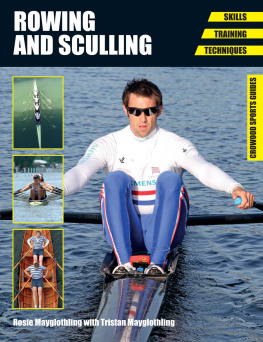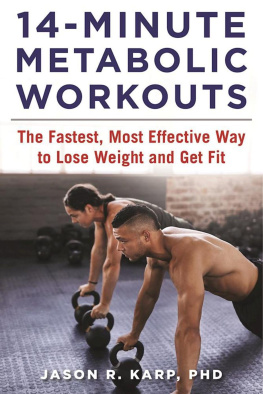Hatherleigh Press is committed to preserving and protecting the natural resources of the earth. Environmentally responsible and sustainable practices are embraced within the company's mission statement. Visit us at www.hatherleighpress.com and register online for free offers, discounts, special events, and more. 101 BEST ROWING WORKOUTS Text Copyright 2020 Sarah Fuhrmann Library of Congress Cataloging-in-Publication Data is available.
ISBN: 978-1-57826-845-0 All rights reserved. No part of this book may be reproduced, stored in a retrieval system, or transmitted, in any form or by any means, electronic or otherwise, without written permission from the publisher. Cover and interior design by Carolyn Kasper Printed in the United States
GETTING STARTED:
WHY ROW?
I ndoor rowing's popularity is growing by leaps and bounds, and is fast becoming a trend to truly take the international fitness world by storm.
Once the Rodney Dangerfield of the fitness floor that got no respect, indoor rowing studios, gym classes and home workouts are now all the rage. And with good reason! No other fitness activity offers the same non-impact, total body workout. Each stroke engages all the major muscle groups, including your legs, hamstrings, glutes, abs, back, shoulders, chest and arms. Properly done, the rowing stroke is 60% legs, 30% core and 10% arms. But the best part about rowing? Rowing meets you where you are and takes you as far as you want to go. Despite being portrayed as a soul-crushing torture device, the rowing machine is perfect for whatever level of workout you want to do.
Be it an easy paddle during a recovery week, an endurance-based steady-state row to build conditioning, an interval session to build strength, or a heart- and lung-pounding sprint to really let you go all out, the rowing machine is there for you. That versatility is what makes indoor rowing perfect for people of all ages, shapes, sizes and fitness levels. The rowing machine can be adapted to work for just about everyone: weekend warriors and everyday exercisers, professional and high school athletes, kids, seniors, cancer survivors, adaptive athletes...and so many more. If you can push and pull in some form, we can make it work for you. Welcome to our world!
GEAR AND EQUIPMENT
When preparing for a rowing workout, be sure you wear proper clothing . Rowing is a spandex sport for a reason! Avoid wearing long shirttails or super baggy shorts that can get stuck in the rowing machine's seat and monorail.
Cross training shoes, or shoes with a flatter sole and some flex in the forefoot, are recommended over road running shoes or anything with a thick sole. The reason for this is that any shoe with a thick sole acts to cushion the initial force of your foot acting on the rowing machine. There's no sense wasting effort; make sure it's all going where it counts! Have a water bottle and sweat towel handy, and don't forget some glass cleaner to clean your monorail and disinfectant wipes for the handle and seat once you're done. Please note : Never spray anything directly on the monitor. They are not sealed, and moisture can damage them.
WARM-UPS AND COOLDOWNS
WARM-UPS
Be sure to warm up before every workout.
In fact, if you have been away from any fitness for a long time, a warm-up can serve as your entire workout! Suggested warm-up : Start with the pick drill (arms only, arms and body, slide rowing, slide rowing, rowing, full slide rowing) for approximately 10 strokes or 30 seconds at each length. (Examples of pick drills can be found at www.youtube.com/user/UCanRow2.) Row easy at full slide for one minute, stop, and do some gentle stretching. Then, row at medium pressure at full slide for one minute. Remember to listen to your body and acknowledge what it tells you!
COOLDOWNS
At the end of every workout, resist the temptation to hit the showers as soon as you're done and instead make time to cool down. A proper cooldown aids recovery and sets you up for success in your next workout. Be sure to include some stretches, too! Suggested cooldown: Row easy for two minutes at light pressure.
Then, row the reverse pick drill for 10 strokes at each length (full slide, slide, slide, slide, arms, and body, arms only). Work in a quick stretch and you're done!
SCALING: HOW TO MAKE A WORKOUT YOUR OWN
One of the great things about the rowing machine is that because it's powered exclusively by you (no electricity), it adjusts quickly to your effort level. Never hesitate to push/pull harder or easier to find the right intensity level for you. The same is true for a workout's duration: Just because a workout is written for 5 rounds, for example, doesn't mean that you have to stop there if you find yourself wanting more...or that you have to do that much if you're exhausted after three rounds. In the interval workouts of this book, you will also sometimes see this formatting: Thrusters / squats The second move presented (in this case, squats) is an easier exercise option . In these cases, do whichever works better for you.
Note: form and safety first! Whether you're rowing or doing an off-machine exercise, the minute your technique fails, it's time to either take a quick break or stop entirely.
WORKOUT INTENSITY
Use these numbers to help guide your workout intensity and scale it to your experience and fitness level. No-pressure paddle rowing: Very easy, with low stroke rate and low intensity. A restful pace that requires little effort but still maintains good technique. 50% effort or less. Conversational pace: Comfortable, sustainable over a long period, a warm-up pace.
You can hold a conversation, and the effort is more boring than hard. 55-65% effort. Sustainable: Increased breathing rate; you find yourself focusing on the monitor for feedback. You can talk, but you'd rather not. 65-75% effort. 75-85% effort. 75-85% effort.
High Intensity: Put the hammer down! Short intervals, race pace; no talking, just breathing. 85-100% effort. Disclaimer: As with any other fitness program, please be sure that you're cleared by a doctor or medical professional to row. Despite being low-impact, rowing can be quite hard work, depending on how much effort you put into the workout. If you have back, neck, knee, or hip issues; or other medical conditions such as diabetes or seizure disorders, you should be sure your physician is aware of these and evaluates you accordingly. 
KEY TERMS AND
DEFINITIONS
AMRAP: As Many Rounds As Possible.

KEY TERMS AND
DEFINITIONS

















